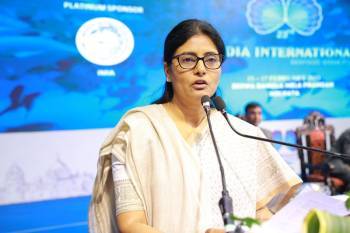KOLKATA, 19 February 2023: India must tap more of its domestic market for shrimps through improved cold-chain infrastructure so as to absorb fluctuations in the international trade of the commodity owing to stiff competition from Latin America and South-East Asia, according to experts at the 23rd India International Seafood Show (IISS).
As Ecuador and Indonesia are “dumping” their seafood items into the US market at far cheaper prices, India can start focusing on domestic consumers who can potentially absorb almost one-third of the national shrimp production, speakers told a technical session of the February 15-17 event being organised in the city by the Marine Products Export Development Authority (MPEDA) in association with the Seafood Exporters Association of India (SEAI).
While domestic prices are better than international for many species of capture and culture fish, India’s internal markets can absorb 30 per cent of the shrimps in the country, speakers noted in their presentations on ‘Seafood Trade & Market Access’.
Union Minister of State for Commerce and Industry Smt Anupriya Patel, who inaugurated IISS 2023, said India wants the US to continue as its important destination for shrimp exports. “We are making moves to regain our seafood market-share in America. The government is moving fast in the right direction,” she said here yesterday.
The speakers at the three-hour session said India’s industry, when it comes to country branding, must come together and follow the example of Ecuador which has achieved a meteoric post-pandemic rise in shrimp production due to a stronger market-share in the US, they said at the interaction moderated by Mr Abraham J. Tharakan, Chairman of Kochi-based Amalgam Foods.
All the same, India is showing signs of product diversification that are guarding it against “too much” direct competition. Only, the country must tap its “immense” scope for value-added marine products. India is able to “comfortably market” its non-shrimp items to all countries, but authorities must go for better conciliation of non-tariff barriers, the speakers added at the session on Wednesday evening.
SEAI Secretary-General Mr Elias Sait said Ecuador and Indonesia are not on the anti-dumping duty radar of America, whereas India was being imposed a duty of two per cent or more. Overall, India’s export basket is dominated by shrimps, constituting almost 75 per cent of value and 55 per cent in quantity terms.
The US has been the largest importer of frozen shrimps from India, catering to more than 40 per cent of America’s demand for the commodity. “Ecuador, with its proximity to America and considerable logistic advantage, increased its production of aquaculture shrimps from 400,000 MT in 2017 to 13,00,000 metric tonnes in 2022,” he noted in his presentation on Market Access Issues – Status and Way Forward’.
Noting that India is able to comfortably market its non-shrimp items to all countries, Mr Sait said the total US market for shrimps is around 850,000 tonnes annually. “We supplied 375,000 (44 per cent) of these in 2021-22, which dropped by 20 per cent during the current financial year. This was mainly due to Ecuador increasing its shrimp production and supplies to the US at cheaper prices. India substituted this drop in the US market-share by increasing exports to China, EEC (European Economic Community) and other countries,” he explained.
Tapan Mazumder, Additional Director-General of Foreign Trade, said the government is renegotiating for an enhanced free trade agreement (FTA) with South Korea to where India exported 3,864 tonnes of seafood. “One round of the discussions got over, and the second is slated for next month,” he said.
In his talk titled ‘Leveraging FTAs for Better Market Access’, Mr Mazumder highlighted the need for “simple and clear” Rules of Origin that determines a product’s economic nationality.
Willem van der Pijl, Founder and Owner of Netherlands-based Shrimp Insights, said India and neighbouring Bangladesh have seen a decline in their global seafood supplies, while Vietnam has a “slightly more” positive trend. One tactic to move forward was diversification of product and market, with stronger focus on EU market and domestic market development, he noted in the presentation titled Global Shrimp Trade — Status and market prospects.
George Chamberlain, Founder and Former President, Global Seafood Alliance, stressed the need for embracing innovation to improve the whole chain of breeding, hatching, nutrition, grow-out and processing. Mr Kuntal Sensarma, Economic Adviser, Ministry of Food Processing Industries, also spoke on the initiatives and schemes of Ministry of Food Processing Industries, GoI, which are beneficial to the Seafood Sector in India.
Chairing the session, Tharakan stressed the need for enhanced trade facilitation and building strong partnerships while ensuring that the quality of traded goods meets global standards.




















